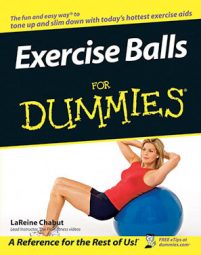Besides developing good overall muscle tone for your entire body, the ball provides numerous other benefits that range anywhere from rehabilitating back, hip, and knee injuries to delivering a powerful workout to improve core stability, posture, and muscle balance. You also improve your flexibility and your cardiovascular system by using a low-impact workout.
Following are a few of the most important benefits for anyone wanting to use the ball and get a little background on what exactly you're supposed to be working.
Back and spine health
The ball is great if you have back problems because it supports your lower back as you exercise and stretch. And that's exactly why physical therapists and chiropractors started using the ball for therapy. So many people suffer from back strain and injuries these days that thinking of anyone you know who hasn't is a challenge. What other object can you think of that you can simply lay your body over and feel instant relief? Not too many.
Core stability
With so much talk these days about working your "core," you may be wondering what the heck your core actually is. Well, the core is the muscles in your body that stabilize and support all your movements. Your core, or what people used to call your "midsection," is made up of the deep abdominal and back muscles that work as stabilizers for your entire body. These muscles are the "deep" muscles because, although you cannot see them, they maintain the core stability in your body.
The three muscles in the midsection, or "trunk" of your body, are
- Transverse abdominus: The deep abdominal muscles
- Tultifidus: The back muscles that support the lumbar spine
- Quadratus lumborum: The muscles of the lower back that maintain spinal and pelvic balance
These muscles work together to protect your spine and help with everyday activities. Lifting, throwing, bending, reaching, and running use the stabilizer muscles, so keeping them well-conditioned is extremely important. Without conditioned stabilizer muscles, simple movements like pulling, walking, and running go unsupported and leave you at risk for injuries.
Training on the ball is one way to work this group of hard-to-reach muscles. Just by sitting on the ball, you're able to activate the stabilizer muscles and not only improve your posture, but you also feel more in touch with your center of gravity. This is just one of the many benefits you get from adding exercise balls to your fitness program.
The additional core muscles that lie deep within your body and are impossible to see from the outside include the pelvic floor and are otherwise described as the muscles that run from your tailbone to your pubic bone.
To tighten the pelvic floor, you simply activate the muscles you use when you're desperately looking for a bathroom and can't find one! (Your muscles should feel as if you're trying to "hold it" or keep from going to the bathroom.) Just sitting on the ball activates these muscles. At first, keeping your balance may be difficult because the ball is an unstable base and requires you to have great strength in your back and abdominal muscles.
When you sit on a chair or a weight bench at the gym, you certainly don't use any of these stabilizing muscles that your body calls upon while you're working out on the ball. By bringing your feet closer together when you're sitting on the ball, you can intensify your workout by altering your base of support. After a few sessions on the ball, you will become more aware and be able to identify how your core should feel when you're engaging it and will soon be able to maintain your balance on the ball just as you would if you were sitting on a chair.
For training your core on the ball, the rule of thumb is: The farther away the ball is from the core of your body, the more difficult maintaining your balance is. For example, when doing a push-up on the ball, placing the ball underneath your lower legs makes doing the push-up much easier because the ball is closer to your core. To increase the difficulty, all you have to do is roll the ball out to your feet so it's farther away from the center of your body, and so maintaining your balance is harder.
Posture
For years, dancers were always told to press their backs "into" the floor or to have a "flat" back. Nowadays, experts have found that maintaining the slight natural curve in your spine is healthier. When using the ball, maintaining this natural curve is important to help you keep from arching your back and to protect the spine.
Muscle balance
When one muscle group is stronger than its opposing muscle group, this causes a muscle imbalance. Muscles that need to work together to perform a particular task, such as the triceps and biceps, are a good example of muscle groups that can have a muscle imbalance.
The muscles that are in the front of your body, or the anterior muscles, are naturally stronger than the muscles that lie along the back of your body, otherwise known as the posterior muscles, because you use them more frequently throughout the day. To complicate the matter further, most people tend to over-train their anterior muscles and neglect their posterior muscles, which can create bad posture and additional imbalances.
The ball offers a solution to muscle imbalances because it supports the lower back and other posterior muscles during training. To look and feel good, whether you're coming or going, you need to train your buttocks, back, and hamstrings. And maybe concentrate a little less on those biceps!

